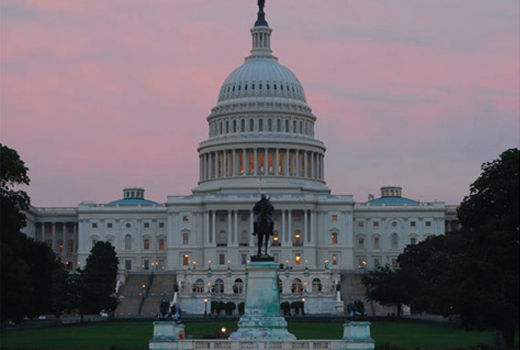Federal Sustainability’s Impact
Amidst the high-profile, highly charged Federal political scene dealing with topics such as health care and terrorism is a very successful, relatively quiet success story – Federal sustainability. A review of recent reports on accomplishments within the Federal community and of award winning agency performances clearly document how much progress has been made. More significantly, sustainability has become a core value and fundamental business practice in the Federal government, regardless of who is in the White House or on Capitol Hill.
On the broader scene, sustainability is the new “in thing.” It is commonly referenced not only in trade journals but also within mainstream media in company and product advertisements as the reason to do things or to buy certain products. It is important to note that sustainability, in its simplest form, means “the ability to sustain.” In other words, it relates to practices and behaviors that can go on successfully for extended time periods. In this context, the word is commonly used as a catch-all term for activities and practices with regard to the environment and natural resources. However, sustainability not only involves the environment but also economic viability and impact on lifestyle and society.
Put another way, “sustainability” means the ability to balance environmental stewardship (which, for this discussion, includes energy and natural resources), economic reality and quality of life; the operative word is “balance.” It does not mean focusing on only one of the three. Therefore, the cheapest or greenest or most lifestyle-enhancing option is usually not the most sustainable. The sustainable option is the one that balances all three.
One can argue that developed countries, such as the United States, had evolved from profit at all costs to environmental protection at all costs, superimposed with, at a minimum, maintaining, if not constantly improving, our quality of life. The evolution is now progressing to a more balanced approach. This is not unique to developed countries, but the focus on which of the three sustainability components is most important varies. For example, today’s developing countries tend to figure in environmental and social issues more prominently earlier in their economic development than the U.S. and Europe did during their respective industrial revolutions.
In the global marketplace we have seen corporate and organizational commitments and initiatives evolve from “going green” to being “sustainable” to now being “socially responsible.” “Going green” focused on environmental protection. “Being sustainable” meant environmental stewardship in the context of sound economic and market factors. And “socially responsible” reflected environmental stewardship executed in an economically smart fashion with a stronger emphasis on and integration with social issues.

© iStockphoto.com/nano
How does this relate to the Federal government’s progress? One can see the same patterns in government. As far back as 1969, in the opening section to the National Environmental Policy Act (NEPA), is a commitment for the government to operate and to protect the environment in a sound and viable manner for generations to come. It was and is an undertaking that is a precursor to the sustainable development definitions that proliferated in the 1970s, ‘80s and ‘90s – so well captured by the famous Brundtland definition often used by many organizations.
This commitment manifested itself early in how the law was applied to Federal tax dollar use in the context of environmental impact assessments. Then, in the late 1980s, efforts aggressively ramped up to “green” federal operations and to better manage the government’s own footprint. As we entered the 1990s with the Clinton Administration, a series of Executive Orders mandated recycling, waste reduction, energy efficiency and transportation fuel conservation. This characterized the “going green” phase of the aforementioned cycle.
In the late 1990s and early 2000s these practices became more integrated, and a visible connection to the economic and lifestyle value of such practices in the Federal government was crystallizing. In 2007 a new Bush Administration Executive Order (EO 13423) was issued. It built on the successes of earlier Executive Orders and practices by integrating various goals of separate orders into one. While reducing the number of pages, the new order more importantly memorialized the transition from “going green” to being “sustainable.” It integrated practices to capture the benefit of synergy by tying efforts more closely to fiscal and economic prudence and by making it clear that the goal is not only a cleaner and healthier environment but also a more efficient government with a more productive workforce and agency mission success.
Two very important points are evident from this progress. First, the government is becoming more aware of its role as a consumer of goods and services and its impact on the national and global marketplace. In other words, the government realizes that by implementing these sustainable practices, it not only helps its own environmental, social and economic footprint; but it also helps catalyze markets for society’s benefit. Examples are the Federal commitment to high-performance sustainable buildings and to sustainable electronics. The government’s immense buying power and market share with respect to these products guarantees greater availability for the general marketplace.
Second, this Federal sustainability evolution occurred across several Presidents of both parties. And the current administration’s apparent commitment not only to continue on this path but also to go even further helps demonstrate that Federal sustainability is here to stay. These requirements have become fundamental elements of how agencies operate, and we are rapidly approaching a point where NOT having these goals and commitments would be disruptive and counterproductive. Although clearly each President will put his or her “flavor and mark” on the goals, the fundamental point is that the government wants to be sustainable, and it sees the benefits. Sustainability is now so ingrained in normal agency operations that arguably it is not even political, let alone partisan. Most of the government is, after all, composed of career public servants, not political appointees. If sustainability is inherent to that broader workforce, then it is not political.
However, at least in the beginning politics played a role because Executive Orders are presidential documents that survive only as long as the sitting President wants them to survive. So there had to be “political” value to a new administration to continue the effort – especially if it were something that a prior President had implemented. But in 2007 a sea of change occurred when Congress, through legislation, began to memorialize elements of these Executive Orders. In other words, they became the law of the land. The Energy Independence and Security Act of 2007 memorialized many elements of Executive Order 13423. And pending legislation will continue to blur the line between executive branch and legislative branch origins of requirements. This further demonstrates the “depoliticizing” of Federal sustainability.
What does the future hold? If the pattern continues, the Federal government will evolve from being sustainable to being more socially responsible. This means taking sustainability to the next level with more emphasis on the impact on lifestyle and the social condition. The current President’s strong commitment to energy independence and climate change demonstrates a greater visibility of elements that have strong social components. This will bode well for all Americans. We will benefit from a government that strives to be more efficient with our tax dollars, to be better stewards of our resources and to lead by example via catalyzing markets so that we can all afford to be sustainable.





























